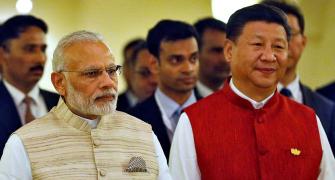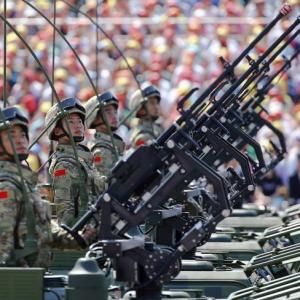'Does the Indian army's new assertiveness risk a clash escalating into shooting and possibly skirmishes?' asks Ajai Shukla.

The territorial and boundary dispute between India and China is a complex, historical, multi-layered wrangle across a sprawling 3,500 kilometre-long border.
Yet, a relatively simple disagreement has brought patrols from both armies eyeball-to-eyeball on the Sikkim-Tibet border since June 16 and led to China blocking the travel of Indian pilgrims to Kailash Mansarovar through the Nathu La border pass.
At issue is sovereignty over a scenic, 4,000 metre-high pasture called Doklam -- less than 100 square kilometres in spread.
India claims that the Chumbi Valley, a dagger-shaped wedge of Chinese territory protruding southward from the Tibetan plateau, ends north of Doklam at the Batang La pass.
China asserts ownership of Doklam, too, claiming the boundary runs south of the pasture, along the dominating Gyemo Chen mountain, which China calls Mount Gipmochi.
Complicating this otherwise straightforward dispute is Bhutan, since the tri-junction of the Sikkim-Tibet-Bhutan boundary falls here.
Bhutan's claims are supportive of India's.
Except for Ladakh, which lies northeast of the Himalayas, the de facto Sino-Indian boundary, called the Line of Actual Control, broadly follows the Himalayan watershed.
The commonest form of dispute -- and there are 14 separate disputes along the LAC -- is whether one ridgeline, or the neighbouring one, constitutes the watershed.
The 1962 war was sparked off near Ziminthang by disagreement over whether the boundary ran along the Thagla Ridge, as India claimed, or along the Hathungla ridgeline to its south, as China contended.
The 1986 Sumdorong Chu confrontation, which saw India moving tens of thousands of troops to the trouble spot, was over the tiny Thangdrong grazing ground near Tawang, with India claiming the watershed ran north of that meadow, and China claiming it was to the south.
At Walong, too, at the eastern end of the Sino-Indian boundary, disagreement centres on which ridgeline constitutes the watershed.
These small disputes over the alignment of the LAC are sub-sets of a major overarching territorial dispute -- in which China claims all of Arunachal Pradesh (Southern Tibet); and India claims the Aksai Chin plateau.
Many of the 14 sub-disputes on the LAC are over relatively inconsequential grazing grounds and meadows.
However, the ongoing standoff at THE tri-junction, at the southern tip of the Chumbi Valley, is over territory that both Beijing and New Delhi regard as strategically important.
Indian military planners worry that letting Beijing extend the boundary southwards to Mount Gipmochi would bring China closer to the Siliguri corridor -- a narrow sliver of Indian territory between Nepal and Bangladesh -- which connects India's seven north-eastern states with the Indo-Gangetic plain.
In fact, advancing to the Siliguri corridor would require Chinese troops to break through strong Indian defences in Sikkim and advance southwards more than 100 kilometres through difficult jungle terrain -- a tough military task.
The beleaguered Chinese units that do make it to Siliguri would have to beat back inevitable Indian counter attacks.
Even assuming that China obtained control over the Siliguri corridor, India could simply bypass the corridor, moving through Nepal or Bangladesh.
If India's sense of vulnerability over Siliguri is overblown, Beijing's wish to extend the Chumbi Valley southwards is incomprehensible.
Of all China's border vulnerabilities, the Chumbi Valley is perhaps the greatest.
It is a narrow salient overlooked by Indian defences, which can cut off the valley from Tibet by wheeling east from north Sikkim, capturing it at leisure.
Strategists regard the capture of the Chumbi Valley as an obvious wartime target for India's Mountain Strike Corps when it is operational.
By extending the Chumbi Valley southwards, therefore, China would only be expanding a key vulnerability.
Why then is Beijing pressing its case for the Doklam Plateau so determinedly?
The answer is probably that, unlike many claims elsewhere, Beijing has an arguable case here.
As China's foreign ministry spokesperson spelt out in tedious detail last week, the 1890 Anglo-Chinese Convention Relating to Sikkim and Tibet specifically mentioned Mount Gipmochi as the tri-junction of China, India and Bhutan.
True, Beijing rejects as 'colonial impositions' other British era agreements, like the 1914 Simla Convention that birthed the McMahon Line.
But there is a difference -- China actually signed the 1890 agreement, and not the 1914 one.
Beijing also argues that Jawaharlal Nehru endorsed the 1890 agreement in a 1959 letter to Zhou Enlai.
Beijing also cites a pasture land claim over Doklam, arguing that the yak graziers of Yadong have long held grazing rights over Doklam, and that graziers from Bhutan paid a 'grass tax' to Yadong graziers if they wanted to herd there.
China's foreign ministry claims the Tibet archives still possess 'grass tax' receipts from earlier times.
The grazier argument is a powerful one in borderlands peopled by nomadic herders. Both China and India use it to back their territorial claims in other disputed sectors.
Although Beijing has made Indian withdrawal a precondition for de-escalating the Doklam face-off, Indian forces are showing no sign of blinking.
This firmness follows a pattern seen in earlier patrol confrontations in Ladakh, like in Daulet Beg Oldi in April-May 2013; and in Chumar in September 2014.
Over the preceding decade, India's defensive posture has been greatly stiffened by raising two new divisions in the Northeast; an armoured brigade each for Ladakh and the Northeast; a mountain strike corps currently being raised and major improvements in India's air defence and air strike capabilities.
Whereas once, China bullied India on the LAC and -- as it is attempting in Doklam -- built roads, tracks and bunkers as 'facts on the ground' to consolidate its position in any future negotiation; today the Indian Army is rightly willing to, and capable of, physically blocking such attempts.
The question then is: Does the army's new assertiveness risk a patrol clash escalating into shooting and possibly skirmishes on a wider front?
There has been no shooting on the LAC since 1975, a peace bolstered by the successful 'Peace and Tranquillity Agreement' that New Delhi and Beijing signed in 1993.
China has pressed for additional agreements, most recently a 'Working Mechanism for Consultation and Coordination' in January 2012; and a 'Border Defence Cooperation Agreement' in October 2013.
Yet, inexplicably, Beijing continues to resist Indian calls to formalise the LAC's alignment -- an important first step towards resolving the larger territorial dispute.
A clear LAC alignment, recognised by both sides, would end the imperative to 'create facts on the ground'.
This would also greatly reduce patrol clashes -- and tamp down the nationalism sentiment in stands in both countries in the way of a comprehensive settlement.
Paradoxically, India's pro-active LAC stance is creating incentives in Beijing for an LAC settlement.
Yet, calibrating the aggression and managing each patrol confrontation remain tricky balancing acts.
Until an LAC agreement comes about, New Delhi must develop the instruments and expertise needed for managing such crises.











